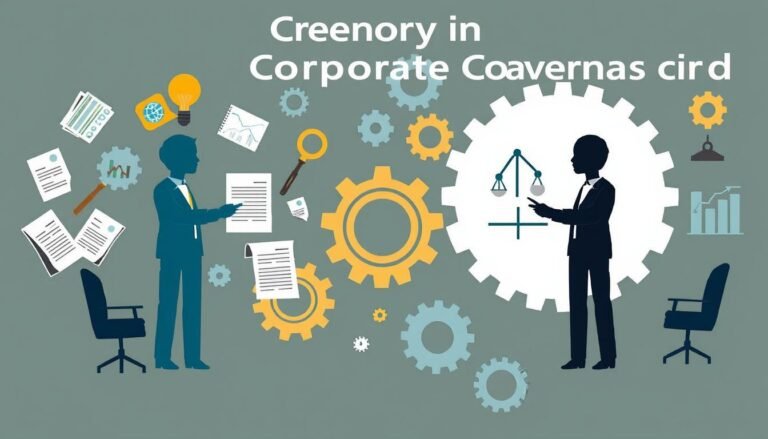Understanding Risk Management Framework Essentials
Is your organization ready for the threats in today’s digital world? With data breaches and cyber threats common, having a strong Risk Management Framework (RMF) is key. It helps in identifying, measuring, and reducing risks. Risk management is more than just following rules; it’s a way to grow and innovate sustainably.
Organizations are turning to standards like NIST, COBIT, and COSO for cybersecurity and information security. These frameworks make risk assessment easier and help in responding to new risks. This article will explore the basics of RMF, its importance, and how it helps in modern business.
Key Takeaways
- Risk Management Frameworks are essential for managing security and privacy risks across various sectors.
- NIST RMF provides a comprehensive 7-step methodology for mitigating security risks.
- FISMA mandates federal agencies to conform to NIST standards to ensure security.
- COBIT offers a governance framework that aligns IT objectives with business goals.
- COSO provides guiding principles for effective enterprise risk management.
What is a Risk Management Framework?
A Risk Management Framework (RMF) is a set of guidelines for handling risks. It helps organizations deal with risks in a structured way. By using an RMF, companies can identify, reduce, and assess risks better.
Having a strong RMF is key. It lets organizations make plans to handle risks that could harm their work.
Definition and Purpose
The RMF has five main parts: identifying risks, measuring and assessing them, reducing risks, reporting and monitoring, and making sure everything follows rules. Companies use these parts to make a solid risk plan.
They follow seven steps: prepare, categorize, select, implement, assess, authorize, and monitor. This helps them manage risks from start to finish.
Identifying risks is a constant task. It helps companies stay ready for new threats. By assessing risks well, companies can plan how to deal with them. They might use cyber insurance or security controls.
Reporting and monitoring risks are key to seeing if these plans work. Risk governance is also important. It makes sure employees follow the right risk management steps.
Using a Risk Management Framework can lower legal risks and increase profits. It works well for both businesses and nonprofits. The RMF offers a full way to handle different risks.
Importance of Risk Management in Modern Business
In today’s complex business world, effective risk management is key. Companies that use strategic risk management are five times more likely to gain stakeholder trust and achieve better results, says PwC’s Global Risk Survey. The focus on compliance and cybersecurity shows the need for strong practices to tackle threats early.
Now, 78 percent of managers worry about cyber-attacks, making cybersecurity the top business risk. Companies that focus on risk assessment and management can grow faster. They expect to see double the growth rate, as the PwC survey found.
Risk management helps protect against big financial losses. For example, workplace misconduct cost U.S. businesses over $20 billion in 2021. Corporate fines for misconduct have jumped 40 times in the last two decades. This shows how important a risk management framework is to avoid legal and financial problems.
Financial companies often have a risk department led by a Chief Risk Officer (CRO). But nonfinancial industries may not have this setup, facing more complex risks. An Enterprise Risk Management (ERM) program helps by bringing together different departments to manage risks well.
A strong risk culture makes a company more accountable and transparent. It makes sure everyone knows about risks. This matches up with international standards like ISO 31000, which guides on managing risks.
| Benefit | Impact |
|---|---|
| Protection against Financial Losses | Safeguards assets and enhances profitability. |
| Preservation of Reputation | Maintains public trust and investor confidence. |
| Seizing Opportunities | Identifies and capitalizes on growth potential. |
| Enhanced Decision-Making | Informs strategies with data-driven insights. |
| Business Resilience | Fosters adaptability in a dynamic market. |
For modern businesses, a thorough risk management plan is crucial for lasting success. It’s key for companies to see the many benefits of risk management. This includes building a proactive mindset to tackle new challenges.
Key Components of a Risk Management Framework
A strong Risk Management Framework has several key parts. These parts work together to help an organization manage its risks well. The main parts are risk identification, risk assessment, risk mitigation, risk monitoring and reporting, and risk governance.
Risk identification is the first step in a good framework. It uses methods like brainstorming, reviewing documents, and planning scenarios. This helps organizations make smart decisions and use resources wisely.
After identifying risks, the next step is risk assessment. This can use both numbers and expert opinions. Quantitative risk assessment puts risks into financial terms. Qualitative risk assessment uses expert views to judge risks by severity and likelihood.
Then, organizations work on risk mitigation strategies. These strategies include avoiding, reducing, transferring, or accepting risks. It’s important to use security controls and safeguards at this stage to protect against threats.
Risk monitoring and reporting are key to a strong risk management practice. They help organizations keep up with changes. This means regular updates on risks and how well security controls work.
Finally, risk governance is crucial for accountability and oversight. It sets roles and responsibilities, trains staff in risk management, and encourages open talk about risks.
| Component | Description |
|---|---|
| Risk Identification | Methods to uncover potential risks, including brainstorming, SWOT analysis, and expert consultations. |
| Risk Assessment | Evaluation of risks through quantitative and qualitative assessments to quantify potential impacts. |
| Risk Mitigation | Strategies to reduce or eliminate risks through avoidance, reduction, transfer, or acceptance. |
| Risk Monitoring & Reporting | Ongoing reviews of risk status and the effectiveness of security controls. |
| Risk Governance | Establishing roles and responsibilities for risk management and fostering a risk-aware culture. |
Risk Management Framework Process Overview
The RMF process is key for managing risk well. It has seven main steps that help create a strong risk management plan. These steps include Prepare, Categorize, Select, Implement, Assess, Authorize, and Monitor. Together, they form a full plan for risk analysis.
The RMF brings together security, privacy, and managing risks in the supply chain. It works for both new and old systems, covering many technologies like IoT and control systems. This makes the RMF process good for all kinds of organizations, big or small.
To keep systems safe, NIST SP 800-53 controls are picked after careful risk checks. The RMF also stresses the need for ongoing checks. This ensures that controls keep up with new threats and fit with the company’s rules.
| Step | Description |
|---|---|
| Prepare | Establish a risk management strategy that aligns with organizational goals. |
| Categorize | Classify information systems based on the impact of potential risks. |
| Select | Choose appropriate security controls tailored to identified risks. |
| Implement | Deploy selected security controls within the system environment. |
| Assess | Evaluate the effectiveness of implemented security controls through rigorous testing. |
| Authorize | Obtain management approval for system operation based on assessed risks. |
| Monitor | Continuously track the performance of security controls and identify emerging risks. |
This structured method helps with full risk management. It also boosts accountability and governance in the organization.
Common Standards: NIST, COBIT, and COSO
Three key standards guide risk management: NIST, COBIT, and COSO. Each framework helps organizations meet compliance and improve governance.
NIST, from the National Institute of Standards and Technology, offers a detailed Risk Management Framework (RMF). It covers steps like preparation, categorization, and security control selection. NIST helps organizations tackle risks, especially in cybersecurity.
COBIT, created by ISACA in 1996, focuses on IT governance. COBIT 2019 brings new principles for better internal control. It’s crucial for following laws like the Sarbanes-Oxley Act (SOX) and reducing IT fraud risks.
COSO, started in 1985, focuses on internal control and financial risk reporting. The COSO Framework has eight components, including governance and strategy. It helps organizations stay compliant.
Using COBIT and COSO together offers big benefits. It blends COSO’s focus on financial duties with COBIT’s IT governance. This mix helps organizations manage risks well in complex IT settings.
In summary, using NIST, COBIT, and COSO helps manage risks, meet compliance, and strengthen governance.
| Standard | Focus Area | Key Components | Compliance |
|---|---|---|---|
| NIST | Cybersecurity and Risk Management | Preparation, Categorization, Security Control Selection, Implementation, Assessment, Authorization, Monitoring | U.S. Government Agencies, Private Sector |
| COBIT | IT Governance | Planning and Organizing, Delivering and Supporting, Monitoring | SOX Compliance, IT Risk Reduction |
| COSO | Internal Control and Financial Reporting | Governance and Culture, Strategy and Objective-Setting, Performance | Financial Risk Reporting |
Benefits of Implementing a Risk Management Framework
Using a Risk Management Framework (RMF) brings big benefits to an organization. It makes things run smoother and can cut costs by up to 20%. This happens when risks are found and fixed early.
Also, managing risks well builds trust with stakeholders. A 2022 study showed that 46% of Americans pay more for brands they trust. When companies show they handle risks well, they gain consumer trust and a stronger market spot.
Recent surveys give us key stats on how risk management affects businesses:
| Benefit | Statistic |
|---|---|
| Increase in risk identification accuracy | 25% |
| Improvement in decision-making accuracy | 90% |
| Decrease in high-impact risks | 40% |
| Increase in overall resilience to risks | 80% |
| Improvement in project success rates | 70% |
| Reduction in financial losses | 50% |
| Compliance rate with industry regulations | 95% |
With more rules changing, managing risks well is key. PwC’s 2022 Global Risk Survey found that those who see risk management as a core skill are likely to see big revenue growth. Deloitte’s 2022 Survey showed only 7% of those facing regulatory changes felt ready for them.
Using tools like Scenario Analysis and Monte Carlo risk analysis makes decisions clearer and more reliable. This leads to better results for everyone, showing why a strong RMF is crucial.
Conclusion
The Risk Management Framework (RMF) is key to handling today’s complex business world. It helps organizations deal with risks and meet standards like ISO 27001 and GDPR. This approach boosts business resilience and makes everyone aware of cybersecurity threats.
Using the RMF makes operations more efficient. It helps spot areas to improve through risk assessments. By setting controls and checking them often, companies can handle risks better. Risk management software also helps make things smoother and keeps focus on what’s important.
Overall, a strong Risk Management Framework turns risks into chances for growth. It helps businesses stay strong and succeed by following best practices. By customizing their frameworks, they can tackle their specific risks well.
Source Links
- Risk Management Framework: A Comprehensive Breakdown | AuditBoard
- Risk Management Framework (RMF): Definition and Components
- What is the Risk Management Framework (RMF)? | Definition from Techtarget
- Risk Management Framework (RMF)- Definition and best practices | Fraud.com
- Today’s Top Risk Management Frameworks | Splunk
- What Is Risk Management & Why Is It Important? | HBS Online
- What is Risk Management and Why is It Important?
- The Importance of Risk Management
- Risk Management Framework: Key Components & Best Practices
- The Fundamental Elements of a Risk Management Framework!
- The 5 Steps of Risk Management
- NIST Risk Management Framework | CSRC
- Risk Management Framework (RMF): An Overview
- COSO vs. COBIT: Framework Basics, Differences, and Examples | AuditBoard
- COSO-ERM, NIST RMF and COBIT
- Top 12 IT security frameworks and standards explained | TechTarget
- Top 7 Benefits of Risk Management – FloQast
- DIACAP or RMF – Benefits of Risk Management Framework for Your Business
- 🚀 Risk Management for CTOs: Steps and Best Practices 📈
- What is a Risk Management Framework? – Intuition







